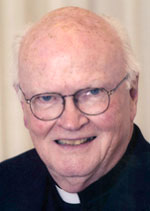I’ve been thinking a lot these days about the geometry of leadership. Those thoughts are prompted by invitations I’ve had to speak to college students about leadership and also by the recent death of a great educational leader, Holy Cross Father Theodore M. Hesburgh, and by the emergence in Iowa and New Hampshire of presidential hopefuls as the primary season begins to heat up.
By mentioning the “geometry of leadership,” I’m calling attention to a top-of-the-pyramid perspective on leadership. Many impute a “king of the hill” attitude to the mind of the leader.
Draw a triangle and picture yourself at the top; the horizontal line running from left to right below can support a wide base of potential followers. They may or may not be responsive to orders from above. If they are, you are exercising leadership. If not, you are whistling in the wind. And note, by the way, the possibility of impalement that is associated with a position at the top of the triangle!
It can be lonely at the top. The top can also be an out-of-touch, can-hardly-see-you, certainly-can’t-hear-you perch that is usually accompanied by title and perks, but is largely ineffective as a power source or center of influence. I recommend instead a “center-of-the-circle” image of leadership.
[hotblock]
There you are, at the center, on a level plane, able to be seen and heard as you yourself see and hear, able to lift (encourage) and touch (pat on the back) because you are also one of the on-the-ground followers even though you carry the title of leader.
I urge students to keep in mind the geometry of leadership as they approach graduation and the world of work, indeed as they work their way toward the top in any career, understanding as they go that the top is really in the center and on common ground with their partners in the enterprise.
Few business schools teach that leadership is a blend of humility and ambition. I recommend that blend, however; it is an amalgam of humility and ambition known as “humbition,” a word worth adding to the would-be leader’s vocabulary. Most films and novels about business overlook humility altogether in their portrayal of business leaders and in their depiction of the qualities of effective leadership.
The qualities that are needed to be a good leader in any organization are integrity, honesty, intelligence, creativity, character, service and commitment. To gain an even fuller understanding of the nature of leadership, you have to add some additional qualities: decisiveness, compassion, respect for human dignity, persistence, perseverance, steadiness and vigor.
A will to succeed has to be there, too; without it, not much is likely to happen.
So there you have it, the geometry of leadership. It applies to business, politics and any form of organizational life. Let those who want to lead ponder the meaning of all the qualities I’ve listed. Let those who elect or appoint others to positions of leadership use these qualities as selection criteria.
***
Jesuit Father Byron is university professor of business and society at St. Joseph’s University, Philadelphia. Email: wbyron@sju.edu.
PREVIOUS: When commenting on service, honesty need not be brutal
NEXT: Children, abortion and the feds’ Christmas surprise




Share this story